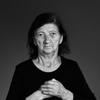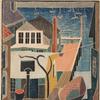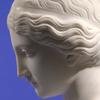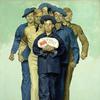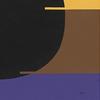Featured 19th Century Painter: ALFRED HUTTY (AMERICAN 1877 - 1954)
- July 22, 2020 11:52
Alfred Hutty was born Grand Haven, Michigan, but spent his youth in Kansas City and Leavenworth, Kansas. At fifteen, he received a scholarship to the St. Louis School of Fine Arts to study stained glass design; however, he was forced to decline the offer due to his family’s financial difficulties. Nonetheless he went to work designing stained glass windows in Kansas City. He later moved to St. Louis, where he met tonalist landscape painter Lovell Birge Harrison, possibly at the Louisiana Purchase Exposition in 1904. Birge was an apparent influence on him for it was at this point that Hutty decided to switch to painting. In 1907, Hutty moved to Woodstock, New York to study under his mentor Harrison, at the art colony there. He concentrated on Impressionist depictions of Woodstock’s scenic mountains, lakes and streams. During this time, Hutty worked for Tiffany Studios in New in New York City, while taking instruction at the Art Students League with George Bridgman and Frank Vincent DuMond. Hutty served his country during World War I working on camouflaging ships--it is unknown whether he was tasked with utilizing the new “dazzle camouflaging” method developed by British marine artist Norman Wilkinson. In 1919, Hutty discovered his “heaven” in Charleston, South Carolina, which became his permanent home, while maintaining a summer studio in Woodstock until his death in 1954. He was a major force in the post-World War I Charleston Renaissance, and the only non-southerner. Charleston had become a draw for American artists and the James S Gibbes Memorial Art Gallery (now the Gibbes Museum of Art) became the focal point for this cultural renewal. The School of the Carolina Art Association, a co-trustee of the gallery, hired Hutty to teach classes in etching circa 1921. In 1923 he co-founded the Charleston Etcher's Club. Hutty’s skill in etching, especially scenes of the Charleston’s architecture and the South Carolina Lowcountry with its Gullah culture, resulted in his being the first American to be elected to the British Society of the Graphic Arts. Among his friends were novelist DuBose Heyward (Porgy, 1925), who modeled an artist in his novel, Lost Morning (1936), after Hutty; and author John Bennett, who wrote on Gullah folk lore. Edisto Island, part of the Lowcountry became one of his favorite spots to paint. Hutty was a member of the Woodstock Art Association; American Watercolor Society, Painters in Watercolor; Charleston Etchers' Club (co-founder); National Arts Club, New York; New Haven Paint & Clay Club; North Shore Art Association, Gloucester; Prairie Print Makers; Rockport Art Association; Salmagundi Club, New York City; Salons of America; Society of American Etchers/Brooklyn Society of Etchers; Society of Washington Artists (DC); Washington DC Watercolor Society/Association; Woodstock Art Association; Society of American Etchers; Chicago Society of Etchers; California Print Makers; Prairie Print Makers Southern Print Makers; and the Allied Artists of America. He exhibited at American Watercolor Society, Painters in Watercolor; Carolina Art Association; National Academy of Design; North Shore Art Association, Gloucester; Paint and Clay Club; Salmagundi Club (1924, prize); Salons of America; Washington (DC) Watercolor Club; Woodstock NY Art Association; Art Institute of Chicago; Corcoran Gallery and/or Art School, Washington DC; Detroit Institute of Art (Scarab Club Gold Medal, 1923); The Pennsylvania Academy of the Fine Arts; Art Institute of Chicago (Logan Prize); Detroit Institute of Arts; Chicago Society of Etchers (1924, medal); National Academy of Design; and the American Watercolor Society.







